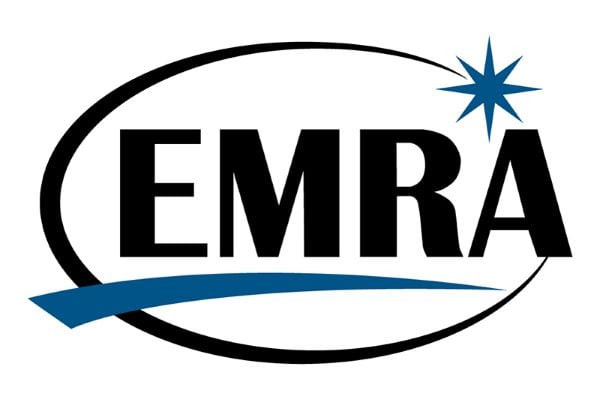Essential Highlights: ERAS 2025 Preliminary Report, 2024 Residency Application Changes, and Osteopathic Medicine Updates
Kelly Dinh, MSIV – Rocky Vista College of Osteopathic Medicine
EMRA Osteopathic Coordinator 2024
Ellis Jang, MSIV – California Northstate University College of Medicine
EMRA MSC Pacific Regional Representative, 2024
Samantha Wilson, MSIV – Edward Via College of Osteopathic Medicine Louisiana Campus
EMRA MSC Southcentral Regional Representative, 2024
Emergency Medicine is making a strong comeback!
Preliminary results from the 2025 ERAS show a 7% increase in emergency medicine (EM) applicants compared to 2024,7 making this a highly competitive year for EM candidates. Here's a breakdown by degree:
- MD applicants: +12%
- DO applicants: +7%
- IMG applicants: +0.8%
There has also been a significant change in combined specialty applications:
- EM/Anesthesiology: +54% increase in applicants
- EM/Family Medicine: +29% increase in applicants
- EM/Internal Medicine: -5.6% decrease in applicants
Percentages were calculated from the 2025 ERAS Preliminary Residency Report Excel Sheet.7
Looking back at 2024, there were 135 unfilled positions, a notable improvement from 554 unfilled positions in 2023.13 The fill rates increased by 13.9 percentage points, with DO applicants accounting for 35% of EM matches and IMG applicants making up 15%.13 It will be exciting to see how the 2025 match reflects this surge in applicants and the resurgence of emergency medicine.
For more information, refer to the ERAS Statistics and 2024 NRMP Match Analysis.
Overview of 2024 Residency Application Changes
- Transition to ResidencyCAS: CORD announced a partnership with ResidencyCAS, offering it as an alternative to ERAS for the 2025-2026 application season.1 Here are some additional resources:
- EMRA article diving into the advantages, obstacles, and how to prepare for the transition: Article Link
- Recording of the CORD Special Session: Video Link
- ResidencyCAS Frequently Asked Questions (FAQ): FAQ Link
- Want to give feedback on ResidencyCAS and/or ERAS/Thalamus? Feedback Link
- Preference Signaling: In the 2024-2025 application cycle, preference signaling was modified to exclude both home programs and away institutions.9 As a result, applicants now have five signals in addition to their away programs, allowing them more opportunities to express interest in residencies that they have not visited.
- EMRA article on signaling in 2024-2025 application cycle: Article Link
- SAEM Breakdown of ERAS signaling: Video Link
Interview Process and Format Updates
Virtual vs. In-Person Interviews:
AAMC released recommendations and guidance encouraging residency and fellowship programs to use a virtual interview format to reduce the financial burden, environmental impact, and promote diversity, equity, and inclusion.2
Virtual Interviews
- Benefits:
- No costly travel expenses
- Greater schedule flexibility
- Creates equal opportunity for all applicants
- Residency programs can connect with a geographically diverse pool of applicants and cut costs associated with hosting in-person interviews
- Challenges:
- Zoom fatigue
- Technological preparedness, including reliable internet connection, professional background, familiarity with virtual platforms, and trouble-shooting technical difficulties
- Difficulty reading non-verbal cues and interpersonal skills
- May be more difficult to establish rapport
In-Person Interviews
- Benefits:
- Better sense of the program culture and environment
- Opportunity to interact with the residents and faculty casually
- May feel more personal and engaging
- Challenges:
- Significant travel costs and time commitment
- Stress related to travel logistics
- May limit the number of programs an applicant can interview at due to costs
Recommendation: Prepare for varying formats. Adaptability is key!
- Applicants should familiarize themselves with the platforms (e.g., Thalamus, Zoom, Interview Broker, etc.) being used
- Create a professional virtual setup
- Practice maintaining eye contact and engagement through a screen
- Be ready to manage travel logistics
- Take advantage of your time spent during away/sub-Internships, personal visitations, and second looks by interacting with faculty, residents, and staff to get a sense of the program culture
Doctor of Osteopathic Medicine (DO) Specific Changes
- Changes to COMLEX-USA and National Clinical Skills Assessment: NBOME has come out with a statement stating enhancements have been done to the COMLEX Level Exams.
- COMLEX-USA Level Exams
- Level 1 and Level 2 will change from 352 questions to 320 questions, maintaining the time frame of 8 hours to complete the exam. These changes will be implemented starting in May 2026 for Level 1 and in June 2026 for Level 2-CE.6
- Level 3 will move from a two-day examination to a one-day examination. Changes will be implemented starting January 2027.6
- More information at NBOME COMLEX-USA Enhancements Link
- National Clinical Skills assessments
- Core Competency Capstone for DOs (C3DO) pilots will continue through 20254
- Announcement on outcomes and next steps will be made July 2025
- Students in graduating classes through 2027 have competency in fundamental osteopathic clinical skills verified by dean through attestation program to help qualify the DO graduate to be eligible to take Level 3
- You can find more information at National Clinical Skills Link
- COMLEX-USA Level Exams
- Commission of Osteopathic College Accreditation (COCA) updates: The Commission on Osteopathic College Accreditation (COCA) implemented changes in 2023 that took effect on July 1, 2024. These changes included updated definitions distinguishing between "core" and "required" rotations.3,5,12
- Core Rotations: (must be taught in the third year by faculty who hold (or have held) board certification, or be board eligible, in the listed specialty)3,5,12
- Family Medicine
- Internal Medicine
- General Surgery
- Pediatrics
- Required Rotations: (must be taught by physicians, but they can be board-certified in other specialties)3,5,12
- Psychiatry (will transition to core status by July 1, 2027)
- Obstetrics and Gynecology (will transition to core status by July 1, 2027)
- Emergency Medicine or Critical Care
- The strategic plan must now include Diversity, Equity, and Inclusion (DEI) for continued accreditation. More details involving the changes made in 2024 can be found here.
What Does This Mean for Osteopathic Students?
Emergency medicine and critical care were neither required nor considered core subjects for most Osteopathic students; however, this was dependent on the institution. For many students, these fields were merely electives, with availability varying by school.
Advantages:
- Early exposure to emergency medicine
- No longer takes up the space of an elective
- Early exposure to emergency medicine gives all students the opportunity to explore this specialty, particularly for those who may want to moonlight in an emergency department as emergency medicine physicians or in other specialties such as family medicine.
Obstacles:
- Some DO schools lack a home or teaching hospital affiliated with the institution, which creates challenges in finding necessary rotations.
- Students may need to travel further to find available rotations. This can be particularly burdensome for fourth-year students who are often responsible for arranging their own rotations, especially if the school does not have established programs or faces competition from other schools.
Recommendations:
- Reach out early and build connections during your rotations to identify potential locations for your emergency medicine rotation.
- Attend conferences to discover which programs accept third-year students for emergency medicine electives and/or offer sub-internships.
Conclusion
There are many changes coming for the 2025-2026 year, and we understand that this can be overwhelming.
For our third-year EM-bound students, we recommend preparing ahead of time, regularly checking for updates, reaching out to a mentor or advisor, and utilizing the resources available to you. Learn from the changes this year to help you get ready for the upcoming application cycle, and don’t hesitate to seek help from those who have been through the process.
For our fourth-year EM-bound students, take a moment to congratulate yourself on almost finishing interview season and preparing for match week! This has been a competitive year for EM applicants, so it is important to show compassion toward yourself throughout this process and recognize how much you have accomplished. Lean on your friends and family for support, contact advisors or mentors with any questions, and enjoy the remainder of your fourth year!
Additional Resources:
- CORD and EMRA student advising guidebook: Book Link
- CORD advising resources: CORD Link
- EMRA advising resources: EMRA Link
- Need a mentor? Mentorship Program Link
- Need advice on fourth year schedule? Schedule Advice Link
References / Citations:
- About CORD: Mission, Vision, Advocacy, and Position Statements. Council of Residency Directors in Emergency Medicine (CORD). Accessed December 18, 2024. https://www.cordem.org/about-cord/mission--vision/advocacy--position-statements
- AAMC Guidance on Virtual and In-Person Interviews. AAMC. Accessed December 18, 2024. https://www.aamc.org/about-us/mission-areas/medical-education/aamc-guidance-virtual-and-person-interviews
- Change in Legal Status, Form of Control, or Ownership of the Institution. American Osteopathic Association. Published March 19, 2024. Accessed December 18, 2024. https://osteopathic.org/index.php?aam-media=/wp-content/uploads/003-Change-in-Legal-Status-Form-of-Control-or-Ownership-of-the-Institution-03.19.24.pdf
- C3DO. National Board of Osteopathic Medical Examiners (NBOME). Accessed December 18, 2024. https://www.nbome.org/c3do/
- Comparison of 2019–2023 COM New and Developing Standards. American Osteopathic Association. Accessed December 18, 2024. https://osteopathic.org/index.php?aam-media=/wp-content/uploads/Comparison-of-2019-2023-COM-New-and-Developing-Standards.pdf
- Enhancements to COMLEX-USA Exams in 2026–2027. National Board of Osteopathic Medical Examiners (NBOME). Accessed December 18, 2024. https://www.nbome.org/news/enhancements-to-comlex-usa-exams-in-2026-2027
- ERAS® Statistics. AAMC. Accessed December 18, 2024. https://www.aamc.org/data-reports/data/eras-statistics-data
- Interviews in GME: Where Do We Go From Here? AAMC. Accessed December 18, 2024. https://www.aamc.org/about-us/mission-areas/medical-education/interviews-gme-where-do-we-go-here
- No Mixed Signals: Breaking Down ERAS Signaling With the CORD Application Process Improvement Committee. Society for Academic Emergency Medicine. Published August 13, 2024. Accessed December 18, 2024. https://www.saem.org/detail-pages/event/2024/08/13/default-calendar/no-mixed-signals-breaking-down-eras-signaling-with-the-cord-application-process-improvement-committee
- NRMP Celebrates Match Day for the 2024 Main Residency Match, Releases Results for Over 44,000 Applicants and Almost 6,400 Residency Programs. National Resident Matching Program. Published March 2024. Accessed December 18, 2024. https://www.nrmp.org/about/news/2024/03/nrmp-celebrates-match-day-for-the-2024-main-residency-match-releases-results-for-over-44000-applicants-and-almost-6400-residency-programs
- Revisiting Preference Signaling. Emergency Medicine Residents’ Association. Accessed December 18, 2024. https://www.emra.org/students/newsletter-articles/revisiting-preference-signaling
- Substantive Change Request: Change in Curriculum or Curriculum Length. American Osteopathic Association. Accessed December 18, 2024. https://osteopathic.org/index.php?aam-media=/wp-content/uploads/Substantive-Change-Request-Change-in-Curriculum-Curriculum-Length.pdf
- 2024 Match Week. ACEP Now. Accessed December 18, 2024. https://www.acepnow.com/article/2024-match-week/2/?singlepage=1
Related Content






